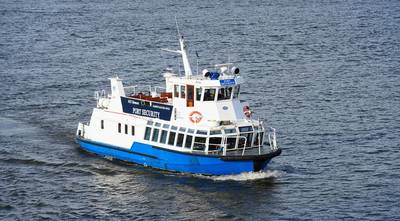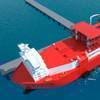Port of Gothenburg Inspection Vessel Set for All-electric Conversion
The Port of Gothenburg announced its inspection vessel Hamnen is set to be converted to run on electrical power as part of the port's wider plan to slash operational emissions.
In service since 1979, the 20.3-meter-long Hamnen is owned and operated by the Gothenburg Port Authority, through the Harbor Master’s Office and Harbor Master Åsa Kärnebro who is responsible for the vessel.
"[Hamnen] has many different duties", said the vessel's skipper, David Falk. "But essentially it’s there to represent the port authority and to make sure that the rules set out in the port regulations are observed."
Falk, who is also project manager of the vessel’s electrification, said replacing Hamnen was considered but deemed unnecessary. "Hamnen is in really good condition, and there’s no other vessel that’s better suited to its assignment. By converting it rather than replacing it, we further reduce emissions, as the vessel will then not be taken into use by a new owner," he said.
Hamnen currently operates approximately 1,200 hours a year, consuming Around 25,000 liters of diesel, the Gothenburg Port Authority said, noting that this represents 67 tonnes of carbon dioxide emissions, which is 15% of its total emissions.
For the conversion, Hamnen will be taken to the Ö-varvet shipyard on the island of Öckerö in the Gothenburg archipelago during the spring, and will return to service in the autumn.
The engine room will be undergoing a total transformation, as Hamnen’s existing diesel engine will be replaced by a totally new electric engine with an output of 250 kW. A four to five tonne bank of batteries with 520 kWh will also be installed, and these can be supplemented by additional battery capacity in the future if required.
"In exceptional cases, special call-outs, unforeseen events or extreme weather conditions may require additional range, so we’re also installing an auxiliary diesel engine that runs on HVO. The vessel’s task is to be available in all contexts 24/7, so we need that flexibility. But the goal is to run on battery power for 90% of the time," Falk said.
Hamnen’s regular berth position in the Port of Gothenburg will be fitted with a 63 amp charger, which is sufficient for charging between regular assignments. Following the electrical power conversion, the vessel will be able to run at least 4 hours at 6 knots.
As part of the SEK 17.3 million refit, in addition to conversion to electrical power, a new, purpose-built wheelhouse will be installed, and a number of measures will be taken to enhance the work environment and extend the useful life
While the vessel is laid up, Falk and the rest of the crew will be using a smaller replacement boat to perform their inspection assignment.
For the Gothenburg Port Authority, Hamnen's electrification is more than another step in the quest to achieve the port’s climate goal of a 70% reduction in port-related emissions from Vinga and over the whole Gothenburg area on the land side by 2030, said Viktor Allgurén, Head of Innovation at the Gothenburg Port Authority.
"As far as the Gothenburg Port Authority is concerned, we have high expectations of our partners both in and around the port and the decision-makers we collaborate with when it comes to climate change, and we need to have everyone on board if we’re going to meet our goals. If we’re going to be able to demand that others contribute to the transition, we must show in all ways that we’re setting an example in the transition. It’s a question of credibility," Allgurén said.














